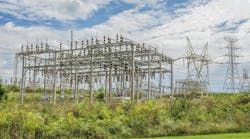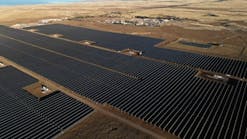Meeting the aggressive climate goals outlined in the Paris Agreement will come down to how quickly and efficiently the world can transition from gas and diesel powered vehicles to electric vehicles (EVs) and integrate vast amounts of new renewable energy sources into the global power supply. Doing so would massively reduce carbon emissions, slow the warming of the planet and give humanity an opportunity to mitigate and reverse the devastating effects of climate change.
However, while much of the focus around the world is on the politics of making this a reality, we can’t lose sight of the technical challenges surrounding these initiatives. The electrical grid needs major upgrades to successfully integrate new renewable energy sources and meet the surging demand. Grid modernization is essential if we want to successfully meet our climate goals and transition to a carbon-free society.
Fortunately, the U.S. federal government has invested substantially to ease the transition, including $369 billion earmarked in the Inflation Reduction Act (IRA) and $2.5 billion for transmission planning in the Bipartisan Infrastructure Law. The environment for renewable energy development is steadily improving. A recent Bloomberg NEF report shows that new investments in global renewable energy over the first six months of 2023 skyrocketed to $358 billion, a 22 percent increase over the previous year.
If we are going to continue to make progress in our mission to solve the planet’s climate crisis, we need to make sure we’re investing this money in the right kinds of projects.
Barriers to meeting decarbonization goals
One of the main technical challenges of boosting renewable energy generation is that renewable energy is often generated in remote areas, far from demand, and needs to be transmitted over great distances to load centers. However, existing transmission infrastructure doesn’t necessarily serve the locations where renewables are being developed. Moreover, the country faces an overall challenge of insufficient transmission capacity between the north and south of the country, as well as east-west links across time zones, between the western and eastern interconnects and the Electric Reliability Council of Texas (ERCOT).
Technology is available to resolve these challenges, but planning and permitting remains sluggish despite the urgency. Given the geographic scope of transmission projects, they often need to be approved by multiple jurisdictions. Unfortunately, planning efforts are not typically coordinated on a national level and planning for many projects can take a decade or more. In the meantime, this transmission bottleneck threatens to slow climate progress at the time when action is needed the most.
An imperative to act now
The world can’t afford to sit and wait for the red tape to clear. Here are three things the industry can do to resolve the energy bottleneck:
Expand and modernize the grid
To meet electricity demand with renewable resources, we need to make the grid more flexible and responsive to enable greater visibility, predictability, and controllability. This requires investments in new transmission links, often using high voltage direct current (HVDC) lines that can transfer large amounts of electricity over very long distances with low losses, as well as power quality solutions to increase the capacity of existing alternating current (AC) transmission infrastructure. Batteries and other energy storage solutions can also help bridge the gap in the peaks and valleys that are inherent in renewable generation and ensure consistency of service. Finally, digital tools such as asset performance management (APM) and distributed energy resource management systems (DERMS) are needed to orchestrate the increased complexity of a grid that relies on a wider variety of energy sources, some of which are highly variable.
Align efforts across the industry
Climate change is too important to continue with traditional approaches to infrastructure development, which have historically been extremely time consuming and often costly. Utilities, lawmakers, regulators, technology vendors, and developers all need to come together to accelerate electrification and the necessary grid modernization investments. While the industry has experienced some supply chain challenges, technology vendors are making investments in both R&D and production to address fast-growing demand. However, better visibility into planning processes and greater certainty in terms of anticipated outcomes and timelines would help companies accelerate their further investments in supply chains to support renewable energy, transmission, and other large infrastructure projects. Hitachi Energy, for instance, has invested $3 billion since 2020 in expanded research and development, operations and manufacturing capacity to optimize our global supply chain. This investment has strengthened our global footprint to ensure cost competitiveness, lead time improvement and flexibility—all factors that will continue to allow us to help lead the climate change fight.
Accelerate national planning
Most importantly, stakeholders across the industry need to collaborate to streamline the permitting process, reduce red tape and evolve the regulatory environment to match the urgency of the climate crisis. A national transmission plan, which the country currently lacks, would be an important step in this direction. Providing greater transparency and certainty to developers would accelerate project delivery and encourage more private investment.
As important, making it easier for utilities to share power between regions would help address time zone challenges, enable better coordination of production and demand and limit disruptions caused by extreme weather — strengthening the flexibility and resiliency of the electrical grid. The U.S. government is aware of these requirements and has characterized them in great detail in recent studies such as NREL’s Interconnection SEAMS study and the DOE’s National Transmission NEEDS study, both of which highlight the need for new transmission.
Accelerating momentum requires industry prioritization
Meeting the climate challenge will require more than building political support. We need to create an environment that encourages faster project development, fosters and rewards innovation and supports a more national mindset and planning process. While investment in electrification and renewable energy has skyrocketed recently, more needs to be done to ensure we are investing in projects that will enable us to meet growing demand. Grid modernization, better collaboration across various stakeholders and regulatory reform are all needed to avoid the worst impacts of climate change.
Anthony Allard is executive vice president and head of North America at Hitachi Energy


